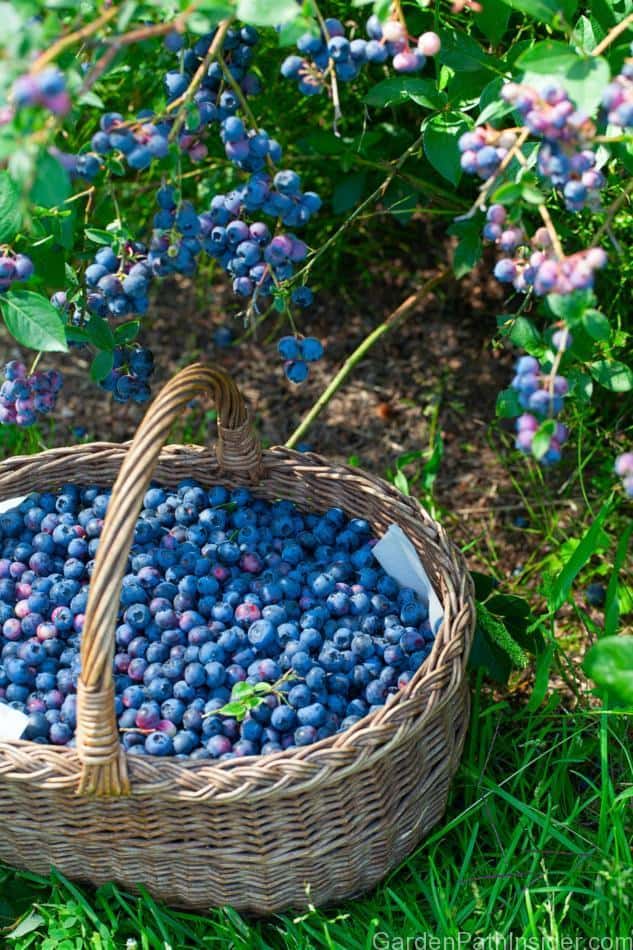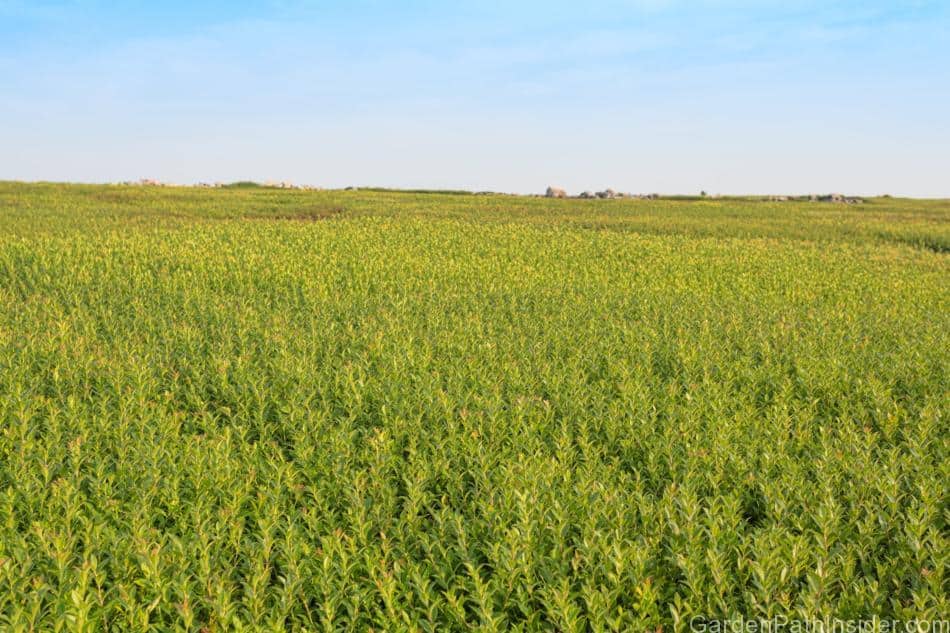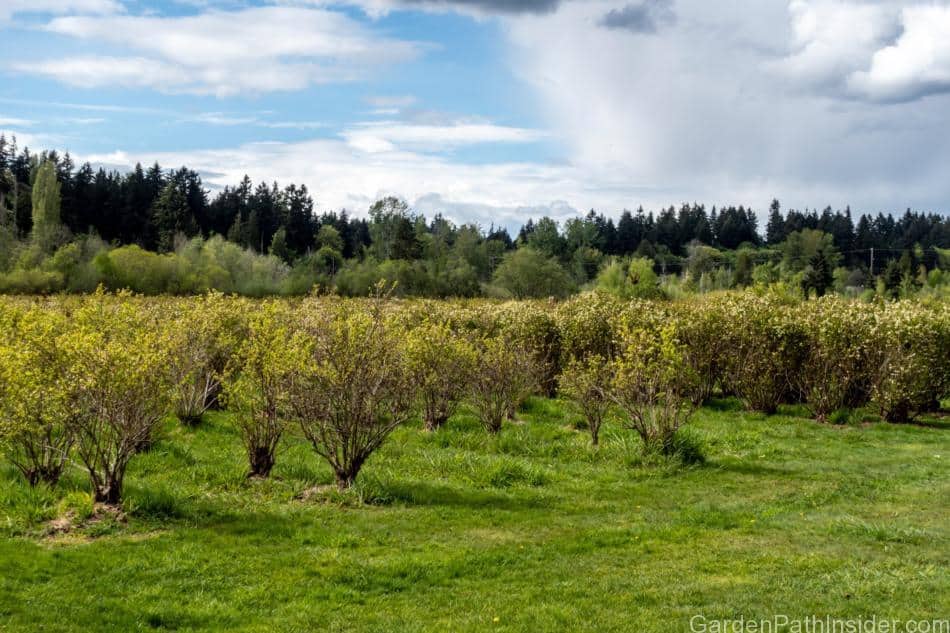
Blueberries are divided into two main varieties of Highbush blueberries, and Lowbush blueberries. Each variety thrives in different soil conditions and ecosystems.
Highbush blueberries require soil pH of 4.5 to 5.5. Lowbush blueberries (wild blueberries) require soil pH of 4.2 to 5.2. Blueberry fertilizers with the NPK ratio of 4-3-6 are ideal to increase soil acidity. Fertilize blueberries in early Spring, and in Fall prior to winter temperatures.
Highbush blueberries require soil pH of 4.5 to 5.5; Source: msu.edu. Highbush blueberry varieties (Vaccinium corymbosum) are cultivated for consistency in size, color, and sweetness of the berries, and the size and consistency of the harvest; Source: usda.gov.
Lowbush blueberries (wild blueberries) require soil pH of 4.2 to 5.2; Source: gnb.ca. Lowbush blueberries (Vaccinium angustifolium) are known as wild blueberries, as these blueberries grow wild in large patches.
Wild lowbush blueberries lack the consistency from one plant to another that the cultivated highbush varieties maintain. The wild blueberries grow in large clusters connected underground by long tendril-like rhizomes.
One wild blueberry plant will spread its rhizomes underground, for large distances of several feet in diameter. As the rhizomes spread, new plants grow through the soil and extend the blueberry patch.
The state of Maine is one of the largest producers of wild blueberries. Maine harvests roughly 20,000 acres annually, bringing in 50 million to 100 million pounds of wild blueberries depending on the health of the crop. Source: umaine.edu
Cover image details: Basket of highbush blueberries © bwf211/123rf.com

Wild blueberries are harvested for commercial sale, and the wild blueberry patches are partially maintained to the extent that the bushes are pruned, and pest control measures are taken by the production companies.
What Is the Best Soil Mix for Blueberries?
Soil blends for blueberries can look different depending on the variety of blueberries and the growing location. However, there are a few simple basics to address when preparing the soil for your blueberry garden.
The best soil mix for blueberries is a blend of organic nutrient-rich soil with a pH between 4.2 and 5.5, mixed with a soil amendment like perlite or vermiculite for added water retention, soil aeration, and extended nutrient delivery. Apply organic fertilizer 2 to 3 times per season to each bush.
Below we review each component of a successful blueberry soil mix in-depth; including soils, and organic fertilizers, and we even cover some common homemade solutions to blending the perfect acidic soil for your blueberry garden.
The best soil for blueberries contains the key nutrients Nitrogen, Phosphorus, Potassium, Calcium, Magnesium, and Sulfur. As we note below, these nutrients can be added to soils that do not contain their presence.
While many organic nutrient-rich soils may contain these nutrients in sufficient quantities, the growing plants could strip the nutrients out of the soil within a single season. As plants grow, the leaves and berries develop and take nutrients out of the soil.
Heavy rains may also wash away the top layers of nutrient-rich soil. Due to these factors and needs, many companies make blueberry-specific soils and fertilizers.
Blueberries of both the lowbush and highbush varieties require soil with a pH that the USDA classifies as Extremely Acidic to Strongly Acidic. Highbush requires a soil pH of 4.5 to 5.5. Lowbush requires a soil pH of 4.2 to 5.2.
Related article: Can You Use Coffee Grounds on Blueberry Plants?
Click Here to read our article on gardening with coffee grounds
The USDA classifies these acidic ranges as noted below.
| Class Term | PH Range |
| Extremely Acidic | 3.5-4.4 |
| Very Strongly Acidic | 4.5-5.0 |
| Strongly Acidic | 5.1-5.5 |
Step one to mixing the proper soil for blueberries is to identify where you will be planting your blueberry bushes. If you are using a pot, then it is recommended to use potting soil specifically made for blueberries. These potting soils are highly acidic, and many are certified organic by the USDA.
When buying potting soil for blueberries, look for certified organic soils that are blended with granular soil-acidifiers, and free of any chemicals as you will be eating these berries. You can find acidic potting soils that are ready to use out of the bag, or you may find large bags of soil acidifiers.
Soil acidifiers are designed to be mixed with soil and lower the alkalinity of the soil. These are designed for blueberries and plants like hydrangeas; these soil acidifiers are not fertilizers.
In the section below titled “Acidic Potting Soil for Blueberries,” we go into more depth on the pros and cons of acidic potting soil vs soil acidifier amendments. See the sections below for more information.
Related article: Can You Use Vinegar to Acidify Soil?
Click Here to read our article on gardening with vinegar
See our reviews and recommendations for blueberry-specific potting soil and blueberry soil acidifier blends, in our recommended garden-gear guide.
If you are planting blueberries in a garden bed, we recommend testing the soil pH before planting. Testing the soil pH is a quick process using an inexpensive electric meter or an at-home soil test kit.
Once you know the pH of your soil you can blend in the specific nutrients that the soil is deficient in, decreasing the chances of burning the plants’ roots with too much fertilizer.
These soil test kits are great to have if you are planting a diverse garden, as you will be able to quickly test each garden bed throughout the season to monitor soil pH and soil nutrient levels.
See our reviews and recommendations for soil pH testers in our recommended garden-gear guide.
Blueberry Fertilizer

Blueberries require specific blends of fertilizer several times per season to aid growth during their critical development periods.
Blueberries require organic fertilizer three times per season; during planting, once buds form, and prior to the winter dormant period. Fertilizers for blueberries should have a Nitrogen, Phosphorus, Potassium, or NPK ratio of 4-3-6 for cell growth, root development, and increased disease resistance.
Below we provide details on the best fertilizer ratio to use in your blueberry gardens, and how to blend the organic fertilizers with blueberry-specific potting soils and soil amendments.
Fertilizer is essential to a healthy garden. Using organic potting soil and soil amendments like peat moss or perlite, aid in the water retention and soil oxygenation of a plant. However, these soil amendments lack the full spectrum of nutrients needed for maximum plant development.
Related article: Perlite vs Vermiculite vs Peat Moss vs Pumice Explained.
In our article ‘Perlite vs Vermiculite vs Peat Moss vs Pumice Explained’, we detail each soil amendment individually and compare each amendment to identify the best use case for all four soil amendments. Read our article; Perlite vs Vermiculite vs Peat Moss vs Pumice Explained’ to learn which is best for your garden.
Constantly during each season, plants are extracting nutrients from the soil. When blueberry blooms begin to form, blueberries will need to be fertilized to supplement the nutrients taken out of the soil by the developing bush.
Fertilizing bushes just as they begin to bud, will replenish the soil of nutrients, and increase the resiliency of the developing buds.
At the end of the growing season, the blueberry plants will need to be fertilized again to support the root system as it prepares for the extended cold season.
See our reviews and recommendations for our favorite blueberry fertilizers, in our recommended garden-gear guide.
Potting mix is a great way to give your blueberry plants a head start. Many premade potting soils also come mixed with perlite or vermiculite, to save you time having to mix the soil yourself. Organic fertilizer should be used in addition to the potting mix to provide the peak environment for blueberry development.
A great potting soil mix, either homemade or store-bought, should include the following:
- Organic nutrient-rich soil/compost
- Soil amendments to aid in water retention and soil aeration. Products like perlite, vermiculite, peat moss, and pumice are great soil amendments to help the soil retain excess water and increase water retention in the soil. These soil amendments also prevent the soil from compacting and becoming too dense for small roots to spread.
Related article: Perlite vs Vermiculite vs Peat Moss vs Pumice Explained.
In our article: ‘Perlite vs Vermiculite vs Peat Moss vs Pumice Explained’, we detail each soil amendment individually and compare each amendment to identify the best use case for all four soil amendments.
Macronutrients Needed in Blueberry Potting Soil
- The blueberry potting mix should also include the key macronutrients listed below, as they are essential for healthy blueberries.
- Nitrogen (N):
- Nitrogen allows plants to create new growth and is critical in cell development. Nitrogen allows plants to create the amino acids needed to develop new cells and plant growth.
- Phosphorus (P):
- Phosphorus supports root growth. Plants with stronger root systems more easily transport nutrients to all parts of the plant, making buds, flowers, and seeds/fruits of the plant much larger and more vibrant.
- Potassium (K):
- Potassium increases a plant’s resistance to disease and the production of energy in the form of carbohydrates.
The nutrients below are included in many fertilizers, as plants grown in acidic soil can become deficient in the nutrients of calcium and magnesium (Ca and Mg).
- Calcium (Ca)
- Calcium aids in the development of plant cells.
- Magnesium (Mg)
- Magnesium allows plants to process sunlight.
Related article: Perlite vs Vermiculite vs Peat Moss vs Pumice Explained.
In our article: ‘Perlite vs Vermiculite vs Peat Moss vs Pumice Explained’, we detail each soil amendment individually and compare each amendment to identify the best use case for all four soil amendments.
Read our article: ‘Perlite vs Vermiculite vs Peat Moss vs Pumice Explained’ to learn which is best for your garden.
When acidic soil (pH<5.0) is inundated with acid rain or other aluminum heavy liquids, the pH levels decrease. This causes the root growth to be stunted causing a lack of water in the plant, inhibiting photosynthesis, and causing the plant to slowly die; according to nih.gov.
Before planting anything in your garden, you may want to run a soil test to identify the current soil nutrient mix/ratio.
Soil test kits can be purchased in any home goods store, or through many online retailers. To learn more read our recommendations on soil testing kits.
See our reviews and recommendations for soil pH testers in our recommended garden-gear guide.
Once you have the results of your soil test you can begin to blend the soil with any missing nutrients.
Many fertilizers come in premixed ratios, though you can easily find any of the P-N-K nutrients sold individually.
See our reviews and recommendations for blueberry fertilizers and soil acidifiers, in our recommended garden-gear guide.
Acidic Potting Soil for Blueberries
Acidic potting soil is sold premixed and can be found at many home stores or online. However, these acidic potting soils may not be the best option for every garden.
Acidic potting soil specifically made for blueberries is most cost-effective when planting a small blueberry garden, or when you plant blueberries in pots. When planting in large garden beds, we recommend adding a soil acidifier to the soil instead of replacing the topsoil with acidic potting soil.
There are many brands of acidic potting soil for blueberries, as each sub-category of blueberries have different soil macronutrient requirements. Below we cover the basics of selecting the correct acidic potting soil for your blueberries.
Highbush requires a soil pH of 4.5 to 5.5.
Lowbush requires a soil pH of 4.2 to 5.2.
Click here to read our reviews and recommendations for Blueberry specific potting soil and blueberry soil acidifier blends, in our recommended garden-gear guide.
How to Acidify Soil for Blueberries
There are many products on the market to increase the acidity of the soil. There are also many organic materials that you may already have on hand, from coffee grounds to vinegar.
Successfully acidifying soil for blueberries requires a starting knowledge of the current soil pH. Once you have the soil pH, you will be able to identify which ratio of N-P-K nutrients is needed to raise or lower the soil pH. Add the N-P-K ratio mix to water and thoroughly water your blueberries.
Below we outline several ways to acidify soil for your blueberry garden. Additionally, we have linked several of our articles below to answer the FAQ on the effectiveness of household products to acidify your blueberry soil.
If you are planting blueberries in pots, we recommend using acidic soil specifically blended for blueberries. These types of premixed soils are great for the initial potting of the blueberry bush. Over the season though, the soil pH should be tested just as the buds are forming, and again just before the cold months begin.
Related article: Can You Use Coffee Grounds on Blueberry Plants?
Read more here, on the pros and cons of using coffee grounds to acidify soil for your blueberry plants.
During the season the growing plant will pull nutrients from the soil, causing the soil pH and nutrient availability to fluctuate. It is very important to replace those nutrients during the critical times of the season when buds start to form, and again when the weather begins to get colder.
Related article: Can You Use Vinegar to Acidify Soil?
Interestingly, rain acidifies soil during rainfall. The EPA states that clean rain has a pH of 5.6, and acid rain contains a pH of 4.3. Both pH levels will benefit all varieties of blueberries.
If you are interested in starting your blueberry garden today, visit our resource page by clicking here. Learn about our favorite stores and websites where we find our plants and garden tools.
